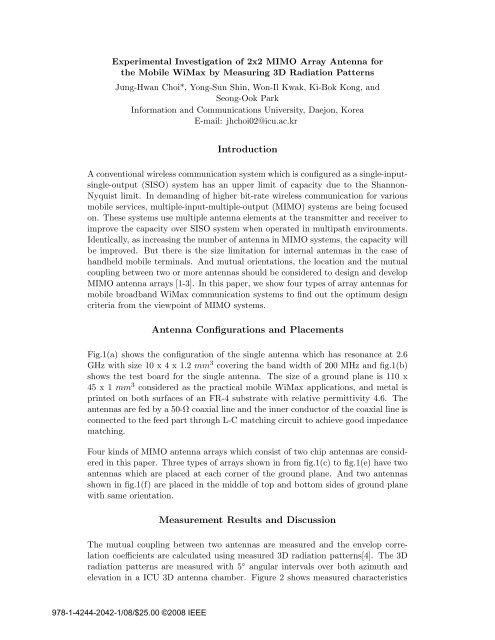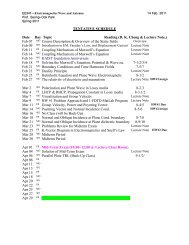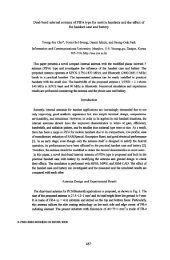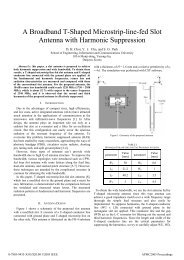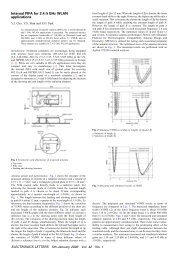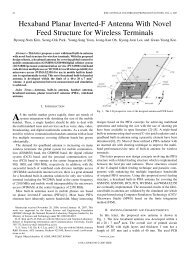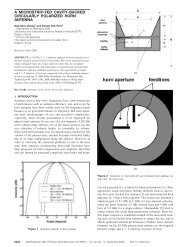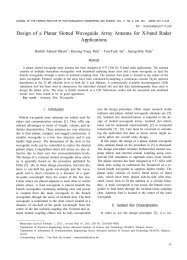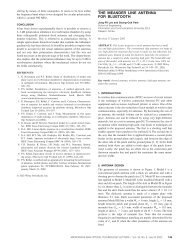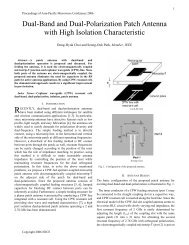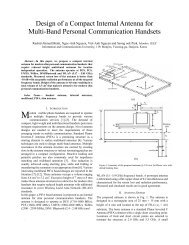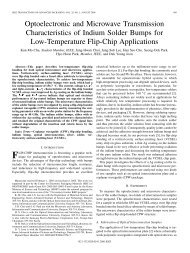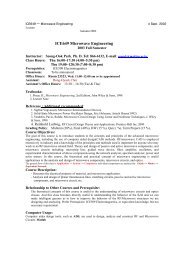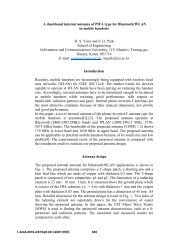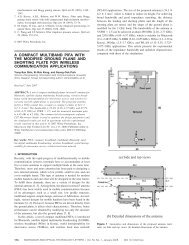Experimental Investigation of 2x2 MIMO Array Antenna for the ...
Experimental Investigation of 2x2 MIMO Array Antenna for the ...
Experimental Investigation of 2x2 MIMO Array Antenna for the ...
You also want an ePaper? Increase the reach of your titles
YUMPU automatically turns print PDFs into web optimized ePapers that Google loves.
<strong>Experimental</strong> <strong>Investigation</strong> <strong>of</strong> <strong>2x2</strong> <strong>MIMO</strong> <strong>Array</strong> <strong>Antenna</strong> <strong>for</strong><br />
<strong>the</strong> Mobile WiMax by Measuring 3D Radiation Patterns<br />
Jung-Hwan Choi*, Yong-Sun Shin, Won-Il Kwak, Ki-Bok Kong, and<br />
Seong-Ook Park<br />
In<strong>for</strong>mation and Communications University, Daejon, Korea<br />
E-mail: jhchoi02@icu.ac.kr<br />
Introduction<br />
A conventional wireless communication system which is configured as a single-inputsingle-output<br />
(SISO) system has an upper limit <strong>of</strong> capacity due to <strong>the</strong> Shannon-<br />
Nyquist limit. In demanding <strong>of</strong> higher bit-rate wireless communication <strong>for</strong> various<br />
mobile services, multiple-input-multiple-output (<strong>MIMO</strong>) systems are being focused<br />
on. These systems use multiple antenna elements at <strong>the</strong> transmitter and receiver to<br />
improve <strong>the</strong> capacity over SISO system when operated in multipath environments.<br />
Identically, as increasing <strong>the</strong> number <strong>of</strong> antenna in <strong>MIMO</strong> systems, <strong>the</strong> capacity will<br />
be improved. But <strong>the</strong>re is <strong>the</strong> size limitation <strong>for</strong> internal antennas in <strong>the</strong> case <strong>of</strong><br />
handheld mobile terminals. And mutual orientations, <strong>the</strong> location and <strong>the</strong> mutual<br />
coupling between two or more antennas should be considered to design and develop<br />
<strong>MIMO</strong> antenna arrays [1-3]. In this paper, we show four types <strong>of</strong> array antennas <strong>for</strong><br />
mobile broadband WiMax communication systems to find out <strong>the</strong> optimum design<br />
criteria from <strong>the</strong> viewpoint <strong>of</strong> <strong>MIMO</strong> systems.<br />
<strong>Antenna</strong> Configurations and Placements<br />
Fig.1(a) shows <strong>the</strong> configuration <strong>of</strong> <strong>the</strong> single antenna which has resonance at 2.6<br />
GHz with size 10 x 4 x 1.2 mm 3 covering <strong>the</strong> band width <strong>of</strong> 200 MHz and fig.1(b)<br />
shows <strong>the</strong> test board <strong>for</strong> <strong>the</strong> single antenna. The size <strong>of</strong> a ground plane is 110 x<br />
45 x 1 mm 3 considered as <strong>the</strong> practical mobile WiMax applications, and metal is<br />
printed on both surfaces <strong>of</strong> an FR-4 substrate with relative permittivity 4.6. The<br />
antennas are fed by a 50-Ω coaxial line and <strong>the</strong> inner conductor <strong>of</strong> <strong>the</strong> coaxial line is<br />
connected to <strong>the</strong> feed part through L-C matching circuit to achieve good impedance<br />
matching.<br />
Four kinds <strong>of</strong> <strong>MIMO</strong> antenna arrays which consist <strong>of</strong> two chip antennas are considered<br />
in this paper. Three types <strong>of</strong> arrays shown in from fig.1(c) to fig.1(e) have two<br />
antennas which are placed at each corner <strong>of</strong> <strong>the</strong> ground plane. And two antennas<br />
shown in fig.1(f) are placed in <strong>the</strong> middle <strong>of</strong> top and bottom sides <strong>of</strong> ground plane<br />
with same orientation.<br />
Measurement Results and Discussion<br />
The mutual coupling between two antennas are measured and <strong>the</strong> envelop correlation<br />
coefficients are calculated using measured 3D radiation patterns[4]. The 3D<br />
radiation patterns are measured with 5 ◦ angular intervals over both azimuth and<br />
elevation in a ICU 3D antenna chamber. Figure 2 shows measured characteristics<br />
978-1-4244-2042-1/08/$25.00 ©2008 IEEE
<strong>of</strong> each type <strong>of</strong> arrays. All antennas in each type <strong>of</strong> arrays have resonance at 2.6<br />
GHz with bandwidth about 200 MHz from 2.5 GHz to 2.7 GHz at S 11 < -10 dB.<br />
Figure 3 shows <strong>the</strong> measured 3D radiation patterns and maximum gain values at<br />
2.6 GHz. Type B has better isolation characteristic and matching condition among<br />
<strong>the</strong>m. There<strong>for</strong>e, it has better gain (4.5, 5.2 dBi) at each port equally ra<strong>the</strong>r than<br />
o<strong>the</strong>r configurations. Table 1 shows <strong>the</strong> diversity per<strong>for</strong>mance results in terms <strong>of</strong><br />
envelop correlation coefficient from 3D measured radiation patterns. All type <strong>of</strong><br />
arrays has correlation coefficient less than 0.5.<br />
Conclusion<br />
This paper investigates four types <strong>of</strong> array configurations with two chip antennas by<br />
considering mutual coupling and envelop correlation coefficient from 3D radiation<br />
patterns. According to proper spacing and polarization between antennas, diversity<br />
per<strong>for</strong>mance may be determined. The envelop correlation coefficients calculated<br />
using scattering parameters may be inadequate because <strong>the</strong> uni<strong>for</strong>m distribution <strong>of</strong><br />
sources is assumed. The radiation-pattern-based method <strong>for</strong> <strong>the</strong> envelop correlation<br />
coefficients can include real environmental factors like angular density function.<br />
Acknowledgments<br />
This work was supported by Acceleration Research(4G Handset <strong>MIMO</strong> <strong>Antenna</strong><br />
Research Center) <strong>of</strong> MOST/KOSEF(No. R17-2007-023-01000-0) and Samsung Electronics,<br />
Co. Ltd.(2007EI4513), Korea.<br />
References<br />
[1] R.G. Vaughan, and J.B. Anderson, “<strong>Antenna</strong> diversity in mobile communications,”<br />
IEEE Trans. Veh. Technol., pp. 149-172, 1987.<br />
[2] G.J. Foschini, and M.J. Gans, “On limits <strong>of</strong> wireless communication in a fading<br />
environment when using multiple antennas,” Wireless Personal communications,<br />
No. 6, pp. 311-335, 1998.<br />
[3] S.C.K. Ko, and R.D. Murch, “Compact integrated diversity antenna <strong>for</strong> wireless<br />
communications,” IEEE Trans. <strong>Antenna</strong>s Propag., pp. 954-960, 2001.<br />
[4] G.F. Pedersen, and J.B. Andersen, “Handset antennas <strong>for</strong> mobile communications,<br />
integration, diversity and per<strong>for</strong>mance,” URSI Review <strong>of</strong> Radio Science,<br />
pp. 119-139, 1996.<br />
Table 1: The Envelop Correlation Coefficient <strong>of</strong> Each <strong>Array</strong>.<br />
Type B Type C Type D Type E<br />
Correlation 0.071529 0.005669 0.028656 0.114716
Figure 1: The geometry <strong>of</strong> <strong>the</strong> proposed <strong>2x2</strong> antenna arrays, (a)<strong>the</strong> geometry <strong>of</strong> <strong>the</strong><br />
chip antenna (basic component), (b)<strong>the</strong> top and side view <strong>of</strong> Type A, (c)Type B,<br />
(d)Type C, (e)Type D, (f)Type E.<br />
(a)<br />
(b)<br />
(c)<br />
(d)<br />
Figure 2: Measured characteristics <strong>of</strong> each type <strong>of</strong> arrays.
Figure 3: Measured 3D radiation patterns <strong>of</strong> each type <strong>of</strong> arrays, left side <strong>of</strong> each<br />
figure shows horizontal polarization component and right side <strong>of</strong> each figure shows<br />
vertical polarization component at 2.6 GHz, Maximum gains <strong>of</strong> H-Pol and V-Pol<br />
are (a)3.3 (b)2.9,4.5, (c)3.0,5.2, (d)3.0,3.1, (e)1.3,4.5, (f)-1.3,-0.12, (g)-2.2,1.1, (h)-<br />
0.2,3.6,(i)-2.2,1.6, unit is dBi.


